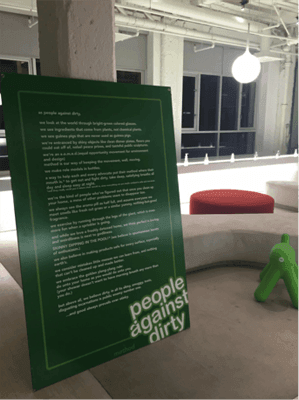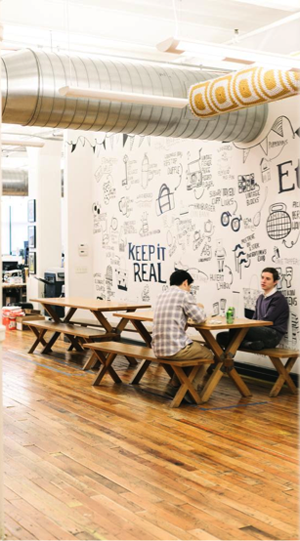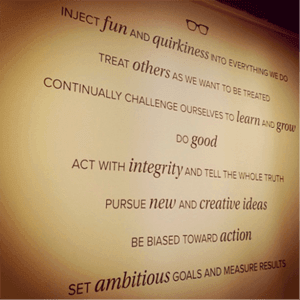Strong mission statements have long guided nonprofit organizations. But mission statements usually focus on external goals rather than internal ways of working. To shape an organization’s internal organizational atmosphere—and to attract talent—nonprofits, social enterprises, and benefit corporations (or B Corps) should consider developing a culture manifesto.
The approaches of B Corps Method Products, Etsy, and Warby Parker offer several ideas for how organizations can go about it.
Method Products (San Francisco-based non-toxic cleaning products company)
According to Creative Director Sally Clarke, Method’s creative team wrote its Humanifesto seven years ago as a fun exercise, with the goal of articulating what the company believes in for employees and customers. The process was organic, she told me; there wasn’t a grand plan, a rubric, or a brief. The team just sat down, brainstormed about what makes Method what it is, and ended up writing 15 fun and quirky belief statements that made them laugh and nod in recognition. Then they stuck what they created on the wall.
Here’s one of those statements: “Everybody into the pool! (We believe in spontaneous bursts of enthusiasm.)”
Are you enjoying this article? Read more like this, plus SSIR's full archive of content, when you subscribe.
Here’s another: “We consider mistakes little messes we can learn from; nothing that can’t be cleaned up and made better.”
 The Humanifesto in the Method office. (Image courtesy of Method)
The Humanifesto in the Method office. (Image courtesy of Method)
Clarke sums up the company’s culture as “the freedom to ‘keep it weird.'” She said that when founders Eric Ryan and Adam Lowry saw a draft of the Humanifesto, it was high-fives all around, and copies quickly made their way to desks and walls. As more and more people started to read it and ask for their own copies, Clarke’s team started to incorporate it more widely into Method’s cultural fabric. They knew the best way to test whether the document really felt authentic throughout the company was to put it out there and see if everyone embraced it.
Today, the Humanifesto lives in several places. It’s included as part of the onboarding kit for new employees and as part of the company’s brand style guidelines. Clarke’s team has a large-format version of the Humanifesto on a board in their office. They periodically rewrite it and polish it up, but the majority of the content—and its spirit—hasn’t changed.
Etsy (Online “handmade” marketplace B Corps based in Brooklyn, New York)
Etsy’s founding values guided the organization long before anyone had written them down in any formal way. But today, the company states them simply and clearly in all its internal and external communications materials. Doing so anchors the organization as it grows, and informs decision-making for everyone in the Etsy community. The values are also easily found on Etsy’s website along with its mission statement.
Etsy’s Values
- We are a mindful, transparent, and humane business.
- We plan and build for the long term.
- We value craftsmanship in all we make.
- We believe fun should be part of everything we do.
- We keep it real, always.
These simple statements guide both Etsy’s external interactions with community members (sellers and buyers), as well as its internal workplace culture. For example, the company wanted employees to be able share their craftsmanship (value #3) while having fun at work (value #4), so it formalized internal skill-sharing practices, and created the Etsy School to make it easier for employees to teach and learn new skills from one another with the company’s support. Sessions like jewelry-making, 3D printing, and Python programming typically happen after work hours, and Etsy helps provide all the necessary supplies. Currently in its 10th semester, Etsy School offers employees a fun, easy way to learn more about each other while continuing to strengthen an environment that prizes curiosity and creativity.
 The Etsy office. (Photo courtesy of Etsy, Zhi-Da Zhong)
The Etsy office. (Photo courtesy of Etsy, Zhi-Da Zhong)
Beyond its values statement, Etsy publishes an annual Progress Report, which it breaks down according to the primary stakeholders in its ecosystem: employees, the community, and the planet that sustains them. In the employees section Etsy shares five principles of culture and engagement, each with a tangible example of how the company lives the principle in practice.
The principles are:
- Leadership is a collective experience
- Data-driven development
- Blameless problem solving
- Fostering innovation
- Generosity of spirit
Examples include insights into Etsy’s feedback practices, its approach to debriefing after a conflict or a problem, and the ways in which it encourages employees throughout the organization to develop new skills. The company has also published an “Employee Happiness Survey” to share how it’s measuring up on its commitment to creating a culture that supports employees’ overall well-being. The survey includes questions that measure employees’ sense of belonging, community, and connectedness to the company, as well as whether they feel aligned with its mission and values, and how they’re doing on a personal level.
Warby Parker (New York City-based eyeglass retailer, also a B Corps)
Warby Parker’s formal cultural values stem from its founders (David Gilboa, Neil Blumenthal, Andrew Hunt, and Jeffrey Raider) and a group of core employees, who wrote down their beliefs about the organization after the company celebrated its first year anniversary.
Fast-forward five years, and Warby Parker’s leaders decided to revisit and update those beliefs and include the entire company in the process. They asked all employees to participate in externally facilitated brainstorming sessions, where they shared their ideas about what to change and voted on which values to keep. When the sessions concluded, the original values remained (with a few words changed), plus the employees added one new value. As one former employee put it, the process was useful because it “felt collaborative. It felt like the culture statement was still a work in progress. The founders wanted to make sure we all believed in them.” (For more about Warby Parker’s process, see this article.)
Creating Your Own Culture Manifesto
As a social enterprise, nonprofit, or B Corps, you most likely have a strong mission and purpose statement. But as these examples illustrate, defining your organization’s core cultural values can help guide internal and external decision-making, foster innovation and collaboration, and even attract talent—today’s workforce increasingly values meaningful work at organizations that have a good workplace culture and environment.
As a first step, sit down with your core team, and make a list of questions you want to ask and answer together. For example:
- How will we make decisions?
- How will we give feedback?
- How will we build trust?
- How will we reward each other and have fun?
- How will we create roles everyone thrives in?
 Warby Parker’s values. (Photo courtesy of Warby Parker’s Instagram)
Warby Parker’s values. (Photo courtesy of Warby Parker’s Instagram)
Once each person has answered these questions, look for patterns within each question area. If you used the questions above, for example, the areas would be decisions, feedback, trust, rewards, and roles.
From there, have each person come up with a “headline phrase” for each pattern, and then vote on which phrases are most important. For example, for the feedback question above, one person might write, “We will give feedback in person, and we’ll do it early and often, so we’re not keeping everything inside until our annual reviews.” Another person might write, “We’ll keep in mind that feedback comes from good intentions.” The headline phrase could be, “We believe in giving in-person feedback with good intentions.” There’s no magic number of phrases, but aiming for between 4 and 10 statements—enough to give some depth to your manifesto, but not so many that it becomes a chore to read. This is your draft version of your manifesto. If you can, bring in an external facilitator to help you share the draft version with all employees and get their input.
Once the statements are set, come up with a visual way to share them. The medium (whether it’s a book, list, poster, statement, or something else) should reflect your company’s personality. Finally, share the final manifesto with the company, and consider posting it publicly to inspire others.
Support SSIR’s coverage of cross-sector solutions to global challenges.
Help us further the reach of innovative ideas. Donate today.
Read more stories by Mollie West.

